|
|
| 'Like' us on Facebook | Follow us: |
Posted on: Jan 10, 2014
 |
A study circle on why Swami hailed Hanuman
as the ideal for His students and devotees
On His 65th Birthday Swami unveiled the gigantic 65-ft statue of Hanuman in the Hill View Stadium. On the day of His Birthday the Lord chose to install the statue of not any of His forms but the image of His devotee. When we in Radio Sai ruminated on this many powerful insights emerged and we ended up recording a lovely one and half hour panel discussion with two other alumni serving in Baba's university. We played this on two successive Thursday Live programmes in December 2013 in the segment 'Outside Inside and Deep Inside' which is hosted by Bishu.
Given the salient points that surfaced in this session we are sure it will help many on the spiritual path to progress towards their goal faster and with much joy. Here is therefore an edited transcript with illustrations of the first two parts of this discussion. We will publish the remaining four parts in the coming weeks.
Part -1
Hanuman at the Pinnacle of Puttaparthi
Bishu Prusty (BP): Sairam brothers Deepak Anand and Sai Giridhar. Many times I have had the chance to go to the Hill View Stadium and whenever I am there one thing that just cannot miss my eye is the towering and impressive statue of Hanuman. It has many times led me to think why Bhagawan placed this huge edifice right at the top. It is only below this statue that we have idols of all the Gods, be it Buddha, Jesus, Krishna, Shiva, or Shirdi Sai. Has this thought ever crossed your mind, Deepak and Giridhar?
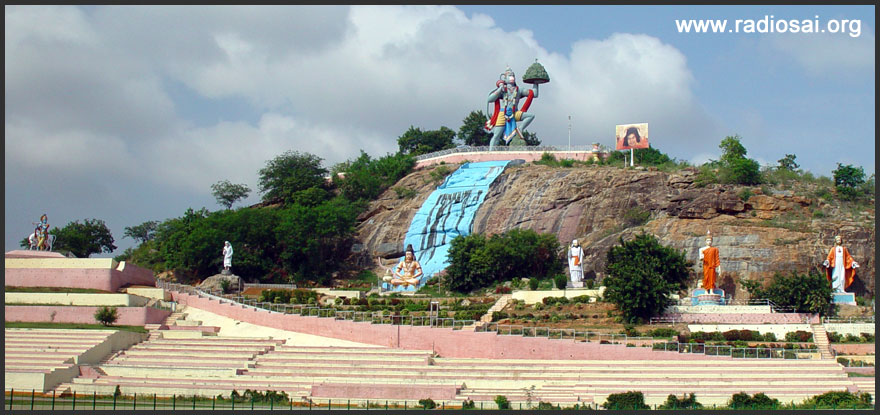 |
Deepak Anand (DA): Yes, of course. In fact Bishu, Lord Hanuman has been the epitome of the ideal that Swami has set for all of us for all times to come.
I remember an incident narrated by one of our teachers sometime back in Sai Kulwant Hall. The boys wanted to present a drama and Swami interacted with them when they gathered in the Bhajan Hall. After some time, Bhagawan asked if anybody had a question and everybody thought someone would ask about the drama or the roles.
Suddenly a small boy got up and said, “Swami, is there anything beyond God?” Everybody obviously was taken aback.
Swami however in His own inimitable style, keeping His hands at the back and swinging from one side to the other, and a beautiful smile on His lips, now looked at the boy and said, “It is L-O-V-E, love!”
So, even the Avatar comes from the infinite ocean of love and manifests Himself as an ideal for all humanity to follow, imitate and reach Him. That is why love is supreme.
On many occasions Swami would emphasise that He is not bound to a devotee per se. He says, “What is a devotee without devotion? I am bound to only devotion. Today if you have devotion, I am bound to you. Tomorrow if you lose it, you are no more a devotee. You may claim you are one, but for God it's only devotion which is important.”
I think Hanuman epitomises this height of devotion. Perhaps that is why this Love which is beyond God Himself is installed by Swami way above the statues of all other forms of God.
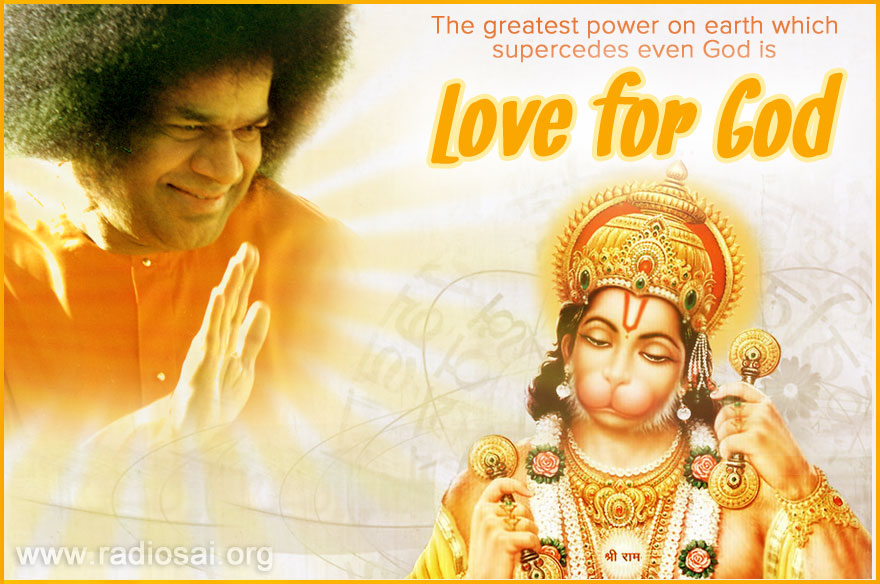 |
BP: Wow! What comes to mind is this famous quote — “The power of your faith in the object is greater than the object of faith itself.” That is what Hanuman symbolises.
Sai Giridhar (SG): Yes. There is evidence of that in the Ramayana. When the bridge across the ocean is being built to Lanka, Swami so beautifully describes how when the name of Rama was written on a single stone and was put it into the ocean it simply floated away. Then Lakshmana actually gives an idea and says, “Why don't you put ‘Ra’ on one stone and ‘Ma’ on the other? Both the stones would come together and combine because of the natural power of the name of the Lord.”
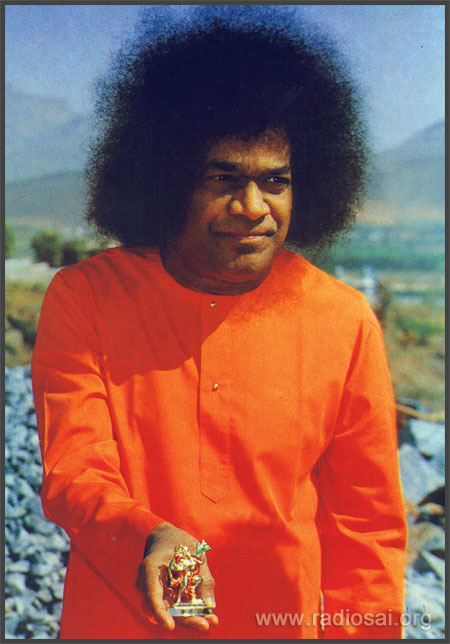 |
|
| To give a comprehensive idea to the engineers about the dimensions and design of the planned statue, Bhagawan materialises this with a wave of His hand |
This was in fact the basis and the strength of Hanuman. There's another very important reason why Hanuman is placed at the top.
If we think about the people who come into the stadium maximum number of times in a given day or even over a period of a year or years together, they are the students.
This is very interesting because Swami has always inspired students to take Hanuman as their example to follow in day-to-day life. Over the sequence of this discussion, I think we should bring out the beautiful characteristics of Hanuman which form an ideal for every youth in this world to follow.
BP: Even as you mention this, the other thought that comes to me is this. Bhagawan could have chosen any other posture of Hanuman like the beautiful silver statue of Hanuman in the Bhajan Hall where he is doing namasankirtan or Hanuman with a mace ready for battle and so on. In fact engineering-wise it was difficult to have a Hanuman whose one hand has to literally hang holding a huge mass of concrete.
SG: It's worth mentioning here that Swami created a 3.5-inch model of Hanuman to be replicated on top of the Hill View Stadium. The best of the engineers were there and were wondering how to make Hanuman's left hand carry a huge mountain and suspend the hand in air.
They were clueless how the structure would stand that way because over a period of time there would be gravitational pressure possibly leading to the entire statue crumbling down.
When they presented their problem to Swami, He said, “Look carefully at the model I have created.” In that, Hanuman's utariya (the cloth which he wears on top) beautifully flows from his left hand on to his thigh. Swami said, “That is like a huge iron pillar which actually supports the hand.” It therefore is an architectural marvel.
BP: I have also read that given the huge height and weight of the structure, someone suggested, “Swami, can we have the inside of the structure hollow? Then its weight would be greatly reduced.”
But Swami said, “No, I want a solid structure because this statue is going to stand for hundreds of years. I do not want anything false or hollow inside.”
The other thing is that Swami wanted the statue to have a pedestal. When they asked Swami how high this should be, He simply said, “My height.”
DA: God is the foundation!
BP: Exactly! And Swami didn't say 5 ft. 4 in., but “My height”. Of course later when they did the calculations they figured that was just the right dimension needed for the statue to be stable.
Swami even mentioned that people who stand at the foot of the hill should be able to see the entire persona of Hanuman. That was the detail Swami went into when He installed Hanuman there. So definitely there is so much more meaning to all of this.
DA: Beautiful! Bishu, so you are saying that this is one statue of Hanuman where he is in action. In fact even in the time of Krishna, Hanuman was there in this same posture, now on the flag of Arjuna's chariot.
BP: It's really fantastic that Hanuman who was there in the Treta Yuga, was the inspiration for Arjuna in the Dwapara Yuga. And the same inspiration continues even now. That same Sai Rama and Sai Krishna, now as Sathya Sai wanted Hanuman right at the summit. Also Krishna too is there in the Shanti Vedika (the stage).
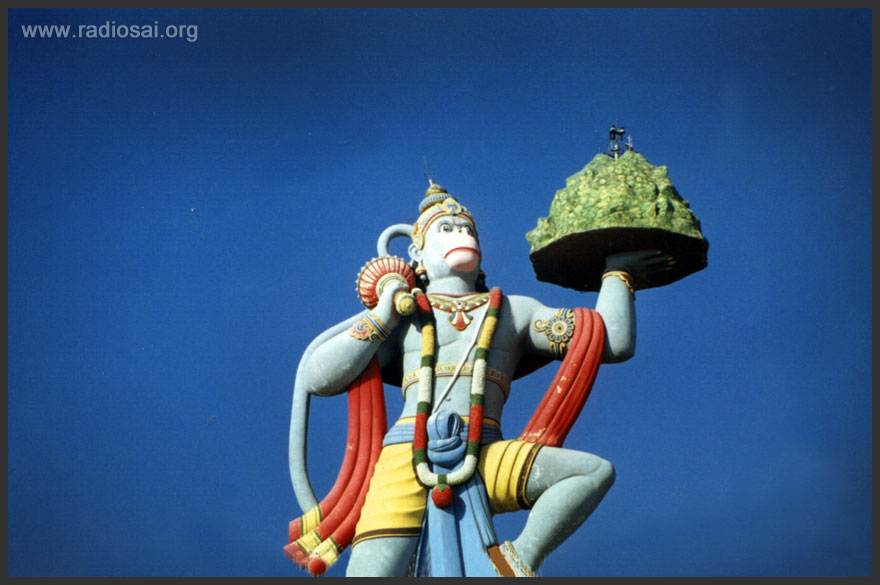 |
| A great confluence of action and devotion, valour and virtue, strength and surrender - the towering example installed by Bhagawan so that no one who enters Puttaparthi can miss it. |
SG: It's beautiful to realise that the scene of the Mahabharata war with Arjuna and his chariot, and Hanuman holding the Sanjeevani mountain atop Arjuna's chariot – both of them in action are there in the stadium. Interestingly, right behind where Swami used to sit and watch the sports and cultural meet. It's phenomenal!
I think the idea of having Hanuman in all-preparedness somehow conveys that every single moment one has to be ready to do Rama Kaarya (Rama's work) or Swami's work.
I remember one instance. If I am not mistaken, it was in July 2005 when Swami had injured His right arm. He returned a little late to Prasanthi Nilayam from Brindavan. Bhagawan gave a discourse on that occasion in which He mentioned, “A day will come when the entire Kulwant Hall will be filled with rice grains and all My students will go and serve the villages around - Nithya Annadanam (continuous and unceasing distribution of food) will happen and My students will do My work.”
He exhorted the senior students to lead and asked, “How many of you are ready?” All of us raised our hands.
Next day we felt we had to respond to Swami's call, and so we prepared a beautiful card, the essence of which was, “Swami, we are ready to be Your hands and Your voice. Please make us Your instruments’.
When we went up to Swami, He said, “Swami ey pani icchina siddhanga undandi”, i.e., “Whatever work Swami gives you, always be prepared and ready to do it.”
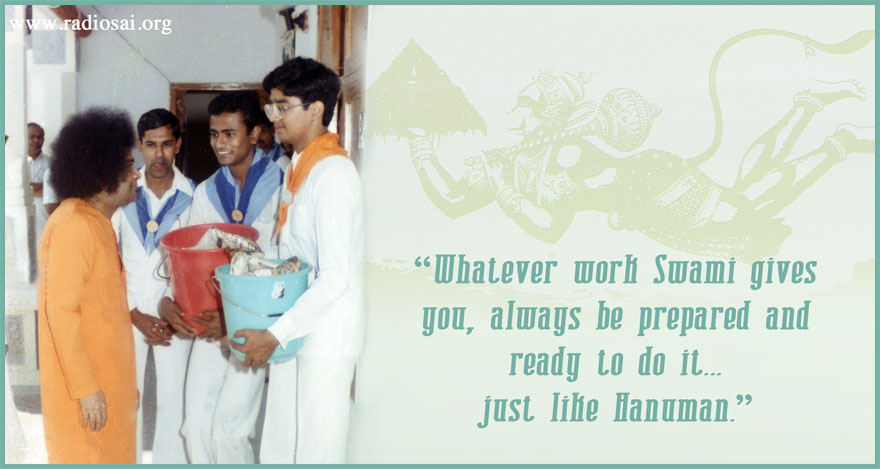 |
I think this pose of Hanuman is such a beautiful symbol for all of us, Swami's devotees and students to be ready every single moment. We have to be alert to find out what we as His nano-little Hanumans can do for Him.
DA: I think in this respect it is also very important for us to understand the great message of Mahabharata — the Bhagavad Gita and the lessons for life from it. Arjuna was very depressed and confused, as the youth of the country many a times may be today. But the Lord by showing him His prowess, the future and His own Vishwaroopa Darshan (cosmic form of the Lord) gave him clarity and said, “You are nimitta maatra (just an instrument). You have to only do your action.”
We are only an instrument and the action has already been performed by the Lord. With that feeling of total devotion, dedication and surrender we must work and only then it becomes Rama Kaarya (God's work). We may be engaged in God's work in the outside world but if we don't have surrender and the feeling of oneness with the Lord, it doesn't really become Rama Kaarya.
SG: In fact Lord Krishna tells Arjuna how to fight the war. He says, “Tasmaat sarveshu kaleshu mama anusmara yudhyacha”, that is “Every single moment of your life think of Me and fight the war”, which is such a potent mantra for each one of us.
I think the act of war is very symbolic because at that moment the action being performed by Arjuna was the war between the Pandavas and the Kauravas — the Dharma Yuddha (the war of righteousness).
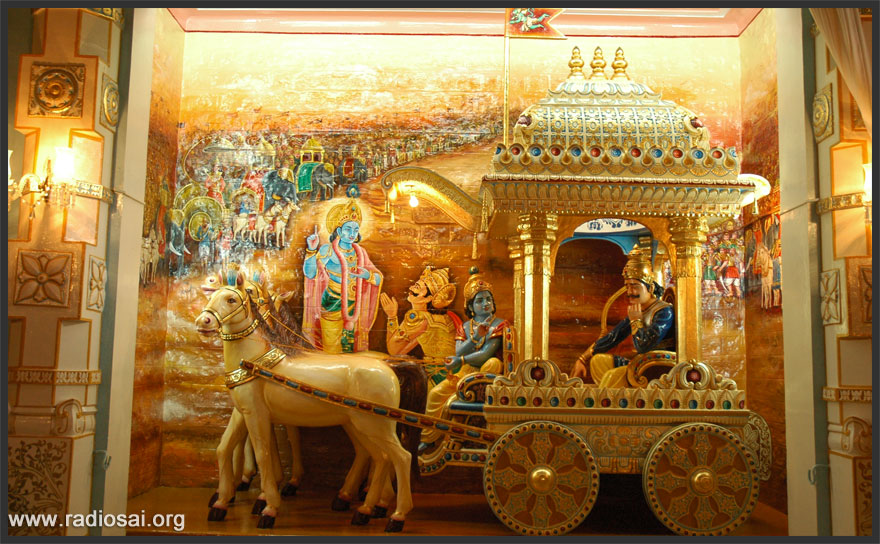 |
| Hanuman, who aided Lord Rama, during the time of Krishna positioned himself atop the chariot to help His devotee, Arjuna win the war. Now when the Lord descended again as Sai Rama, Hanuman is on the summit of the Hill View Stadium inspiring, invisibly guiding and preparing His students to be courageous and walk on the path of truth and righteousness. |
For us every action needs to be motivated by this advice of the Lord — “Every single moment perform your action thinking of Me, knowing that I am the doer.”
This is the same thing Hanuman epitomised. He was the inspiration for Arjuna on his chariot and Arjuna succeeded with this formula.
What do you think about this discussion? Please let us know by writing in to h2h@radiosai.org. Do not forget to mention your name and country.













